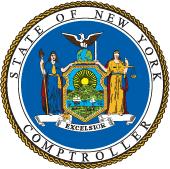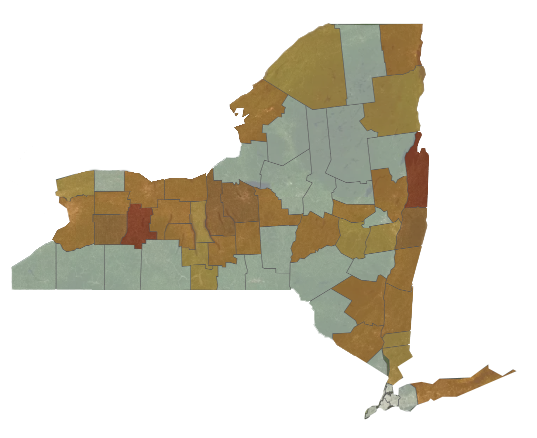Objective
To determine whether the Department of Agriculture and Markets is adequately administering and promoting the Farmland Protection Program to protect agriculturally viable farmland in the State. The audit covered the period from April 2019 through April 2024 and preserved acre data going back to April 2005.
About the Program
Some of the most productive, resilient, and versatile land in the nation forms the foundation of New York State’s farm economy. According to the American Farmland Trust, farms generate over $47 billion in annual economic impact and support approximately 160,000 jobs in the State. Farms play a vital role in the State’s economy and food security. With nearly 7 million acres, farmland composes over 20% of the State’s area. Agriculture also improves New Yorkers’ quality of life in other ways, including providing access to fresh, locally sourced food, preserving open space, and enhancing communities through farmers’ markets and other such activities. Many of the State’s farms face strains and operational stressors such as the pressure to convert farmland to other uses like solar farms or residential homes. Solar energy projects may offer more lucrative incentives to landowners, making solar development a potentially attractive option to agricultural preservation. This, along with suburban development pressures amid the State’s housing crisis and other developmental pressures, has contributed to the State rapidly losing its farmland. U.S. Department of Agriculture Census (USDA Census) data shows that, in the 5 years from 2017 to 2022, the State lost almost 365,000 acres of farmland and 2,800 farms.
The Farmland Protection Program (Program), established in 1996, provides eligible municipalities with grants to implement farmland protection activities. The Program is used to promote the economic viability of farms and help counteract pressures that may drive land out of agricultural production. The Department of Agriculture and Market's (AGM) Division of Land and Water administers grant funding for the Program through:
- Farmland Protection Planning Grants (FPPGs) – help county and local governments develop farmland protection plans
- Land Trust Planning Grants (LTGs) – award State assistance to land trusts for activities that will assist in implementing farmland protection plans
- Farmland Protection Implementation Grants – award State assistance to eligible entities for activities that assist in implementing agricultural protection efforts
Farmland Protection Implementation Grants (hereafter, unless specified otherwise, also referred to as grants) account for over 98% of all funds awarded through the Program and provide financial assistance to eligible entities (counties, municipalities, soil and water conservation districts, and land trusts) to enable them to implement farmland protection activities. Although not set statutorily, in 2014 AGM established a maximum award amount of $2 million per application for grants. AGM establishes specific criteria in each Request for Approval (RFA) to determine eligibility, such as project categories (e.g., beef cattle and hogs, certain cash grains) and minimum acres to be preserved. Each RFA is considered a round with its own project focus and funding. AGM officials review and approve applications for grant projects in the order they are submitted. AGM must determine a project’s eligibility within 90 days of receiving a completed application. AGM divides the State into 10 geographic regions to allocate funding, distributing funds equally among them.
Key Findings
- Grants awarded by AGM have helped preserve approximately 114,000 acres of farmland, involving almost 400 farms between 2005 and 2023. While AGM effectively fulfills its responsibility in awarding and distributing Program funds via Farmland Protection Implementation Grants, LTGs, and FPPGs, in compliance with contract requirements, there are opportunities to enhance its farmland preservation efforts. Specifically, while regions vary significantly in grant eligibility, land values, farmland availability, and Program participation, we found initially allocating funds equally across regions, without considering these regional factors, may contribute to delays in awarding grant funds for farmland preservation. Specifically, AGM allocates funding to the New York City (NYC) Region although it is ineligible to apply for grants and then subsequently reallocates this funding, resulting in grant delays. For instance, we found:
- Round 18 – delayed an additional 233 days on average (longest delay, 352 days) for 20 projects totaling over $20.6 million (6,596 acres)
- Round 19 – delayed an additional 181 days on average (longest delay, 308 days) for 22 projects totaling over $23.5 million (9,668 acres)
If AGM had excluded the NYC Region from rounds 18 and 19 and instead allocated the $5 million (round 18) and $4.5 million (round 19) initially allocated to NYC to the remaining nine regions, the other regions could have each received an additional $555,555 and $500,000, respectively, at the start of each round, allowing the funds to be awarded to projects more quickly. AGM also does not consider factors that impact historical participation in the initial funding allocation.
- We found the $2 million cap, set by AGM in 2014, has a greater impact on regions with higher land values and greater development pressures. Farms in high-value areas may not be able to obtain adequate funding for their farmland conservation in one application. This poses a challenge depending on the size of the farm needing protection. Rising land values and funding constraints make it increasingly challenging for the Program to compete with other developmental pressures. From 2012–2022, land values for each of the 10 regions increased by at least 40%, and half of them increased by over 65%, with Long Island’s increasing by 150%.
- We reviewed historical information AGM maintains on farmland preserved by region and USDA Census data and found Program participation and preservation of farmland compared to available farmland varied widely—and participation isn’t necessarily related to the amount of available farmland. As we noted previously, some of the variances may be a product of how funding is initially allocated, reallocation delays, or the $2 million cap; however, some of the gaps in participation may be because some municipalities and land trusts are not fully informed about the Program or its requirements.
Key Recommendations
- Evaluate the Farmland Protection Implementation Grant allocation and funding methodology and determine whether changes should be made in the distribution of funds and Program participation. The evaluation should include, but not be limited to, considering:
- Revising the regional allocation methodology;
- Increasing grant funding caps; and
- Incorporating relevant data, such as USDA Census and AGM historical data, into grant decisions.
- Work with various stakeholders to tailor outreach and administrative support activities to best serve their needs and promote participation in the Program.
Heather Pratt
State Government Accountability Contact Information:
Audit Director: Heather Pratt
Phone: (518) 474-3271 Email: [email protected]
Address: Office of the State Comptroller; Division of State Government Accountability; 110 State Street, 11th Floor; Albany, NY 12236

